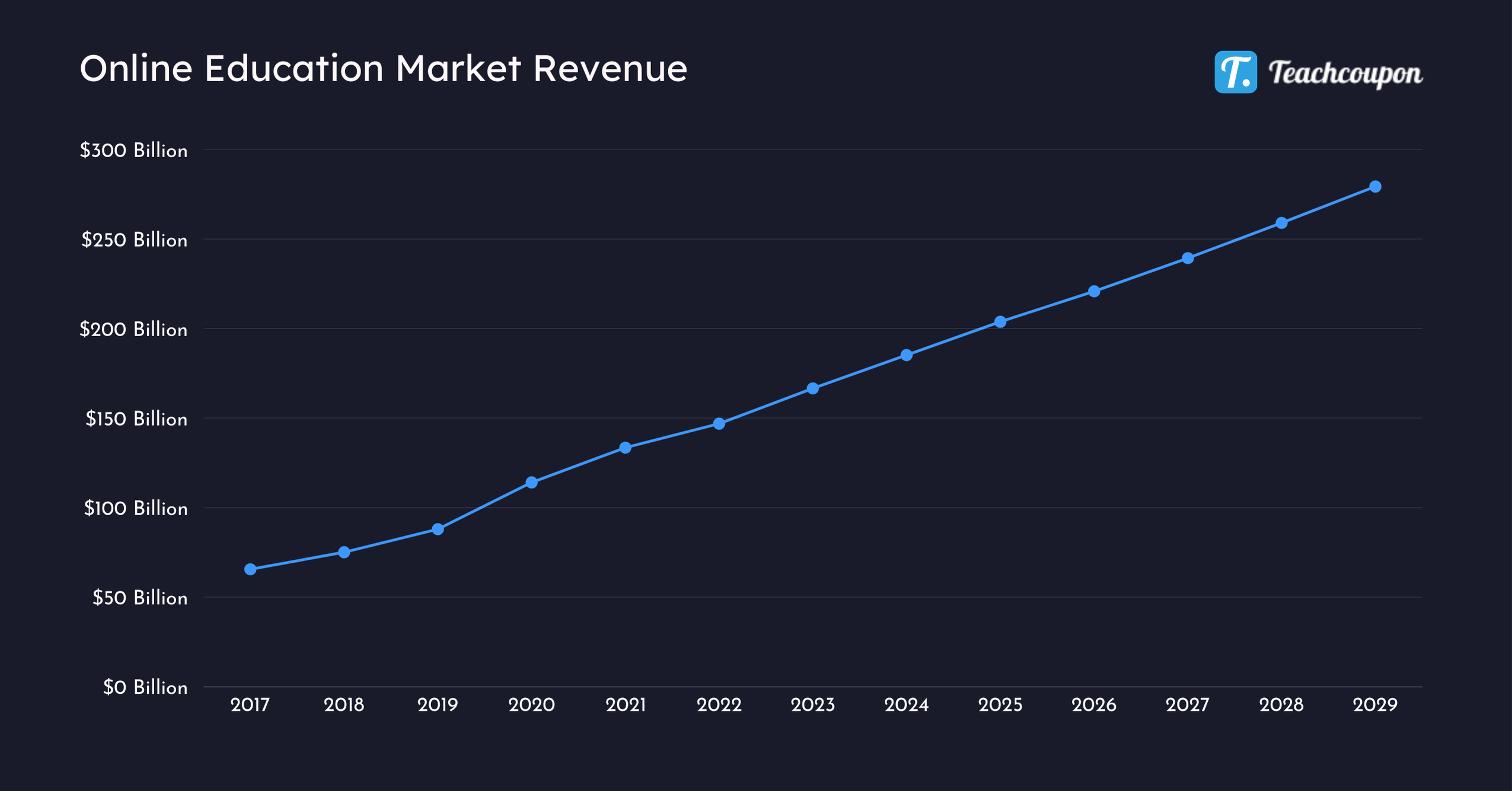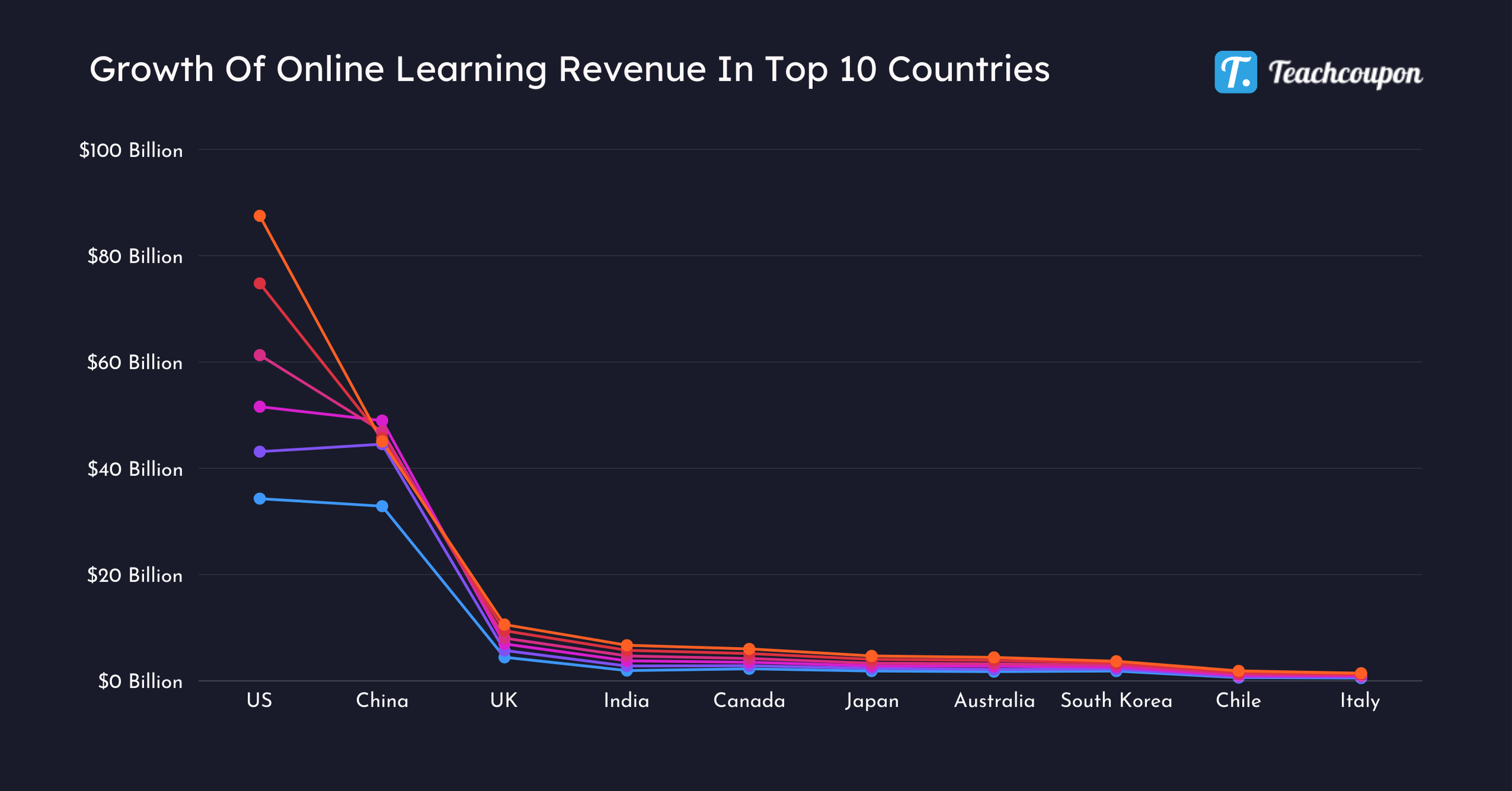Online Learning has become an integral part of the education industry, especially after the pandemic. Statistics reveal a dramatic shift in enrollment patterns, with many institutions reporting a surge in online course participation.
Read on as I discuss up-to-date facts and statistical data relevant to 2024 and beyond.
Top Picks: Online Learning Statistics 2024
- The global online learning market will reach $400 billion by 2026. (Source– Statista)
- Online learning is the fastest-growing segment in the education industry, and it has grown by 900% globally since 2000. (Oxford)
- By the end of 2024, the online learning market will have 73.8 million users. (Source– Market Data Forecast)
- The online education market for universities is expected to hit $120.70 billion in 2024, with the U.S. generating the most revenue of $87.51 billion. (Source– Statista)
- As of today, one-third of students in the U.S. have taken at least one online course. (ResearchGate)
- As per the 2024 CHLOE (Changing Landscape of Online Education), 75% of Chief Online Learning Officers (COLOs) reported that campus-based students request more online options. (Source– Quality Matters)
- Public institutions serve most online learning students, with 72.7% of undergraduate and 38.7% of graduate-level distance learners enrolled in these schools. (Source– Bayview Analytics)
Statistics Of Online Learning Vs Classroom
- 50% of institutions noted that online program enrollment is increasing faster than on-campus enrollment in 2024.
In 2024, about 60% of institutions observed that online classes tend to fill first, indicating students’ strong preference for online learning.
Only 32% of institutions fully incorporated online learning, while 39% still discuss their goals.
One-third of institutions in the USA have fully incorporate online learning in 2024, while another quarter will target specific student groups.
(Source– Quality Matters)
- In a survey conducted in 2024, 70% of students chose online classes over the classroom. (Source– Zion Market Research)
- In the USA, Charter schools offer the highest adoption rate of online courses, with 30.6%.

Here is a look at the percentage of various school types offering online courses:
| School Type | Percentage Offering Online Courses |
|---|---|
| US Public Schools | 29% |
| Charter Schools | 30.60% |
| Traditional Schools | 28.50% |
(Source– NCES)
K-12 Online Learning Statistics
- The K-12 online learning market is to grow at an annual rate of 12.5% from 2024 to 2030 and reach $5.66 trillion by 2030.
- The global K-12 education market is estimated to reach $2.79 trillion by the end of 2024.
- In 2023, the K-12 online learning market was valued at $2.50 trillion. (Source– Grand View Research)
- As of today in the US, the average number of educational tech tools used by K-12 schools in each school district has grown to over 2,500, a big jump from just 895 tools during the 2018-2019 school year. (Source– Statista)
Online Learning In Corporate
- 46% of institutions are working on expanding employer partnerships related to online learning. (Source– Quality Matters)
- A 2024 report shows that 9 in 10 companies today offer digital learning opportunities
- 40% of organizations have mature career development initiatives, prioritizing online learning and offering mentorship and leadership development programs to align with individual career goals and enhance business outcomes.
(Source– LinkedIn Learning Report 2024)
- Companies using e-learning for training, as per the latest study in 2023, reported a 42% increase in employee productivity. (Source– NCES)
- A whopping 74.1% of employers have expressed “readiness” to participate in training and acquire new skills in new market research. (Zion Market Research)
Statistics Of Online Learning During Covid-19
- The pandemic significantly accelerated online education, with 52% of Institutions in 2024 stating that online programs now generate net revenue, up from 47% in 2020. (Source– Quality Matters)
- During the pandemic, online course enrollments increased by 300% globally. (Source– NCES)
- Since the pandemic, 150,000 schools globally have integrated some form of online learning into their curriculum. (Source– Astute Analytica)
- Optimism for online education grew from 82% to 91% post-pandemic.
In a 2021 survey, 76% of students wanted more online course options, and 64% favored a mix of in-person and online learning.
(Source– Bay View Analytics)
Online Learning Effective?
- Learners retain 25-60% of material when learning online, compared to 8-10% in traditional settings. (Source– NCES)
- 69% of teachers believe that online learning is as effective as traditional learning in a classroom.
Meanwhile, 59% of high school students think online learning is more effective than traditional classroom learning.
(Source– World Metrics. Org)
- Online learning has led to a 90% reduction in energy consumption compared to traditional classroom settings. (Source– Growth Engineering)
Negative Statistics About Online Learning
- The dropout rate for online courses can be as high as 80%, indicating significant challenges in engagement. (Source– NCES)
- A cost analysis of online learning in 2020 found that the district incurred approximately 25% higher expenses per student for implementing online classes compared to teacher-directed classes. (Source– Taylor and Francis Online)
- 30% of K-12 teachers feel that current resources for mental health and physical disability support in online learning are inadequate, indicating a gap in available tools and services. (Source– Statista)
- 47% of parents with preschool-age or younger children reported heightened concern about their children’s social skill development lagging due to the pandemic. (Source– Pew Research Center)
Growth Of Online Education Statistics
- In 2024, 52% of COLOs stated that online programs generate net revenue, up from 47% reported in 2020.
92% of chief online learning officers believe online learning helps attract local students, and 87% think it helps students from other areas.
The number of institutions planning new online courses and degree programs remains high, with approximately 69% prioritizing introducing online versions of existing courses.
(Source– Quality Matters)
- The Online Education market is the fastest-growing within the education industry, having experienced an impressive 900% growth rate since 2000. (KPMG)
- A study conducted in 2024 in India predicted that the ed-tech market will reach over 10 billion U.S. dollars by 2025. (Source– Statista)
- 68% of students who did an online course stated they would take an online course again. (Source– NCBI)
- The online education market, including platforms, university education, and professional certificates, is on a strong upward trajectory.
Total revenue is projected to grow from $65.61 billion in 2017 to $279.30 billion by 2029.

Here is year-by-year data from 2017 to the projected growth right till 2029 on the online education market (taking into consideration online learning platforms, online university education, and professional certificates)
| Year | Total Revenue (in billion USD) |
|---|---|
| 2017 | $65.61 |
| 2018 | $75.14 |
| 2019 | $88.02 |
| 2020 | $114.1 |
| 2021 | $133.5 |
| 2022 | $146.9 |
| 2023 | $166.6 |
| 2024 | $185.2 |
| 2025 | $203.8 |
| 2026 | $220.8 |
| 2027 | $239.3 |
| 2028 | $259 |
| 2029 | $279.3 |
(Source– Statista)
- As of 2024, the United States leads online learning revenue growth.
The US online learning market is expected to reach $144.30 billion by 2029. China stabilizes around $45 billion, while the UK and India show significant growth potential.

Let’s examine the growth of the top 10 countries in the online learning sector over the past five years:
| Country | 2019 Revenue | 2020 Revenue | 2021 Revenue | 2022 Revenue | 2023 Revenue | 2024 Revenue |
|---|---|---|---|---|---|---|
| United States | $34.29 | $43.13 | $51.6 | $61.3 | $74.8 | $87.51 |
| China | $32.87 | $44.53 | $48.97 | $46.94 | $45.72 | $45.06 |
| United Kingdom | $4.44 | $5.72 | $6.96 | $8.04 | $9.43 | $10.6 |
| India | $1.95 | $2.81 | $3.78 | $4.71 | $5.76 | $6.71 |
| Canada | $2.27 | $2.86 | $3.51 | $4.21 | $5.14 | $6.02 |
| Japan | $1.85 | $2.35 | $2.82 | $3.34 | $4.06 | $4.7 |
| Australia | $1.74 | $2.16 | $2.76 | $3.21 | $3.85 | $4.41 |
| South Korea | $1.84 | $2.22 | $2.61 | $2.94 | $3.36 | $3.7 |
| Chile | $0.63 | $0.75 | $1 | $1.26 | $1.58 | $1.88 |
| Italy | $0.55 | $0.72 | $0.93 | $1.1 | $1.29 | $1.45 |
(Revenue in billion USD)
(Source– Statista)
Start your online teaching journey and join this booming industry with Teachable’s free trial today!
Popular Online Learning Platforms
- Based on revenue as per the latest data available from 2022, the top three companies in the e-learning market are Adobe Inc. ($17.61 billion), LinkedIn Learning ($14.5 billion), and Coursera ($523.8 million)
Here is a quick look at all the popular online learning platforms:
| Platform Name | Founded In | CEO | Revenue | Website | Geographical Presence |
|---|---|---|---|---|---|
| Coursera | 2012 | Jeff Maggioncalda | $523.8 Million | Link | Global, with learners from multiple regions |
| Adobe Inc | 1982 | Shantanu Narayen | $17.61 Billion | Link | Americas, Europe, Middle East, Asia-Pacific |
| Udemy | 2010 | Greg Brown | $599.2 Million (2022) | Link | Global, accessible to learners worldwide |
| Skillshare | 2010 | Matt Cooper | $14.4 Million | Link | Global audience |
| Skillsoft | 1998 | Jeff Tarr | $141 Million | Link | Global, serving various organizations |
| LinkedIn Learning | 1995 | Jeff Weiner | $14.5 Billion | Link | Global, providing services to professionals |
| Blackboard Inc. | 1997 | William L. Ballhaus | $700 Million | Link | Global presence in educational institutions |
| edX | 2012 | Anant Agrawal | $120.2 Million | Link | Global, with a focus on accessible education |
| iSpring Solution | 2001 | Yury Uskov | $12 Million | Link | Global presence in eLearning solutions |
| Sweetrush Inc | 2001 | Andrei | $14.0 Million | Link | Global, focused on custom learning solutions |
(Revenue in USD)
Future Of Online Learning
- 48% of institutions in 2024 continue to examine how their online learning goals will be integrated into broader institutional strategies. (Source– Quality Matters)
- The global gamification education market is projected to grow from $1.14 billion in 2024 to $5.4 billion by 2029, representing a remarkable compound annual growth rate (CAGR) of 36.4%. (Source– Market Data Forecast)
- The artificial intelligence segment is poised to shape the future of the eLearning market, with a compound annual growth rate (CAGR) of 24.30%. (Source– Grand View Research)
- A 2024 study reveals that 75% of American teachers think AI in online education is the future. (ResearchGate)
